
Remember the scene in “Goodfellas” when they’re in prison?
It’s a classic.
It’s the scene when Pauli Cicero uses a razor blade to slice garlic.
“He sliced the garlic so thin that it would liquify in the pan with just a little oil. A very good system.”
Originally, I thought slicing garlic like this was just good storytelling. Or, yet another outrageous piece of wise-guy lore.
But I was wrong.
Pauli knew EXACTLY what he was doing.
He knew a fact about making food taste better:
Size matters.
And smaller particles makes for better tasting food.
I’ll explain the simple math behind it.
But first, here’s why this is so awesome.
It’s Math, not Myth
I thought it was a bunch of crap. I thought cutting food small enough was good enough.
Wow, I was wrong.
For example:
- The recipes that call for powdered sugar on top? I thought it was unnecessary.
- The top chefs who chop garlic to oblivion? I thought it was excessive.
- The people who use a Vitamix to make smoothies? I thought it was all marketing.
But in all those cases, insisting on getting the TINIEST particles was 100% worth it.
Why?
Because when you make food particles smaller, food tastes better.
And in a lot of cases, smaller particles make food taste DIFFERENT.
How did nobody explain this to me before?
Getting better tasting food and drinks is so simple.
Small particles, people!
A Big Impact on My Body
Before learning this tiny trick (no pun intended), my food was just okay.
Everything I made tasted the same.
My food did not impress many people.
Now?
People think I’m a top chef!
All because I understand that the smaller the particles, the better the food.
So, I’m:
- Snacking more responsibly.
- Enjoying the “regular” meals I make.
- More motivated to create dishes at home (for myself and others).
It’s remarkable.
All it took was accepting that size matters.
Let’s talk about why.
The Math Behind Better Tasting Food
It’s simple math.
But it makes so much sense.
When particles are small, two things happen:
1. More surface area.
Imagine a large cube of sugar. Each side is 4 cm.
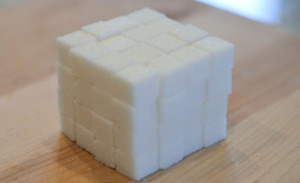
The cube’s surface area is 96 cm².
Here’s the math: 4 x 4 x 6 (surfaces) = 96.
Now…
…imagine cutting the cube into 8, 2 cm cubes. It’s the same amount of food, but over double the surface area.
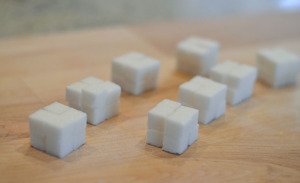
The cubes’ surface area is 192 cm².
Here’s the math: 2 x 2 x 6 (surfaces) x 8 (cubes) = 192.
Ready for one more?
Imagine cutting those 8, 2 cm cubes into 64, 1 cm cubes. It’s the same amount of food, but, again, over double the surface area.
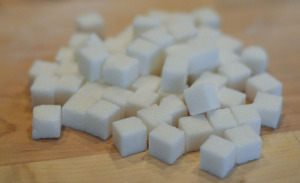
The cubes’ surface area is 384 cm².
The math is: 1 x 1 x 6 (surfaces) x 64 (cubes) = 384.
Here’s a graph of you’re a visual learner.
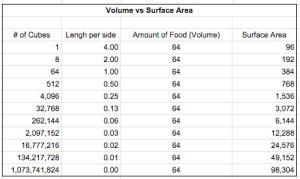
As you can see, the surface gets pretty big as you keep making the particles smaller.
And all the while, the total volume of food stays the same.
So how does surface area impact taste?
We’ll get there.
But remember this: Smaller particles means more surface area.
2. More homogenous mixtures.
Using smaller particles makes more homogenous mixtures. In other words, they can make single phase
Using larger particles makes more heterogeneous mixtures. In other words, they make a varied phase.
This picture says it all.
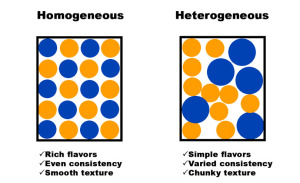
But how does this all make food taste better?
I’ll explain.
Just remember: Smaller particles make more homogenous mixtures.
How Smaller Particles Make Food Taste Better
Smaller particles make food taste better in a few different ways.
Here’s how:
More Intense Flavors
The smaller the particles, the more intense the flavors.
Remember surface area?
The greater the surface area, the greater the intensity of the flavor.
Here’s an example: Powdered sugar.
Powdered sugar particles are so small, they’re basically dust.
And how intense and wonderful-tasting is powdered sugar?
It’s because of surface area.
Surface area is what hits your tongue. The more surface area, the more intense the flavors.
Berry smoothies are another example.
When you pulverize seeds into tiny pieces, the drink tastes MUCH better.
Now it makes sense why chefs obsess over chopping their ingredients.
Also, using tinier particles, requires fewer minutes of cooking. When you cook the food less, flavors are full and intense.
(Yes, the same principal applies to finely ground marijuana. Sorry, Mom, it’s true.)
Summary: Flavors are more intense with smaller particles.
Rich, Even Textures
Imagine a glass of milk. What happens if you take a gulp and there are chunks?
You puke, right?
Now, I don’t recommend anyone drink chunky milk.
Actually, I recommend you don’t drink milk at all.
But the point about even textures holds true for other foods.
- Hummus.
- Sauces.
- Smoothies.
Sure, some things are meant to have some texture.
But many things are better tasting when their texture is perfectly even.
How do you get rich, even textures?
Get rid of the chunks!
Yes, “chunks” are relative to the other particle sizes.
But as you use smaller particles, inconsistencies make less of an impact.
And once they’re gone completely, you get that rich, even texture.
That’s a homogeneous mixture!
For example, give a kid a green smoothie. If it isn’t perfectly, consistently green throughout (no kale pieces), they’re not gonna like it.
But it goes beyond kids.
How do people describe the best hummus, sauces, and smoothies?
- Creamiest.
- Silkiest.
- Smoothest.
All of those imply rich and even.
And homogeneous!
All it takes is tiny particles.
Sure, heterogeneous mixtures are fine sometimes.
But when you’re feeding the pickiest eaters, rich, even textures matter. It’s true with the simplest of dishes.
And guess what?
It’s true for complex dishes, too.
Here’s what I mean.
Symphonic Taste Experience
Think about an elementary school band. The entire ensemble plays identically.
- Same notes.
- Same tempo.
- Same dynamics.
Parents in the audience are impressed. But all outsiders are bored out of their mind.
Now think of a symphonic orchestra.
- Contrast of notes.
- Contrast of tempo.
- Contrast of dynamics.
Which one do you prefer?
Obviously you prefer the latter.
Why?
It’s all about contrast.
The same goes for food.
Top chefs teach their disciples the importance of contrast.
They say that dishes should create a symphonic taste experience.
How do they do it?
Several ways, one of which is contrasting textures.
The greater the contrast, the more “symphonic” the taste experience.
That’s why chefs use a Vitamix as a finishing tool. They’re using the richest, most even textures for contrast.
Even a little extra contrast is a game-changer.
Let Tiny Particles Help You Succeed
The smallest particles make the biggest difference.
If the food you make is just average, that can stand in your way of achieving your health and wellness goals.
Sure, seeking the smallest particles takes a little work.
But, small particles make a big impact on how your food tastes. And a good tasting food makes healthy eating so much better.
Video Demonstration
Big question:
What are some examples of small particles making a big difference in taste experience of the food you make?

3 Vitamix FYI's
1) Our Vitamix cookbook now has 75 recipes! Get the Kindle version on Amazon or get all versions from LINY.
2) Fast Free Shipping: USA 🇺🇸 and Canada 🇨🇦 shoppers get free shipping (all orders, all sizes!) from Vitamix.com. Click to apply
3) Now through forever: Get a free copy of our Companion Kit (ebook bundle etc) and 6 months of VIP support when you notify us of your Vitamix purchase.